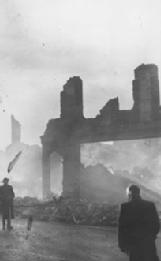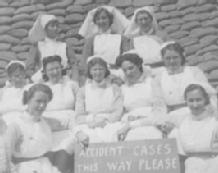The Coventry Blitz
‘Everybody seemed to think this was an ordinary day’s work’
‘Blitz’ is the German word for ‘lightning’ and was adopted by the British press to describe the heavy and frequent bombing campaigns carried out over British cities in 1940 and 1941, during the Second World War. It was, from the German point of view, an attempt to wreck manufacturing, wear down morale, and disrupt the British war effort.
In November 1940, four months after the first British cities were attacked from the air, there was a massive raid on Coventry. Much of the city was destroyed, including all but the outer walls and spire of St Michael’s Cathedral. In just ten hours of unrelenting bombardment, 500 German aircraft dropped more than 500 tons of explosives and nearly 900 incendiary bombs on the city. In total, over 4000 homes were destroyed, along with one-quarter of the city’s factories. Approximately 550 people were killed, and a further 800 injured. The 14 November attack was later seen as the single most concentrated attack on any British city during the war.
‘Our first casualties were usually firemen’
Many of those injured in the November blitz were treated at Coventry and Warwickshire Hospital. These included members of the auxiliary fire service. As Gladys Crichton, an orthopaedic nurse during the war, recorded in her memoir, ‘Our first casualties were usually firemen, who suffered burns from putting out incendiary bombs that sometimes exploded, causing hand and facial burns.’ During the night of 14 November, the hospital suffered a few direct hits, causing the loss of medical stores, but no staff or patients were killed or injured.
The hospital fared much worse the night of 8 April 1941. In this raid the Hospital sustained 10 direct hits, devastating the infrastructure and killing 21 patients, seven nurses, two doctors and three St John’s Ambulance Brigade stretcher-bearers. All of the Hospital’s windows were shattered and there was no heat or water as a result of the bombing; the buildings were in ruins. During the night water was taken from Swanswell, across Stoney Stanton Road, to put out fires.
 The worst damage, however, came the next morning, long after the ‘all clear’ siren had sounded. Just outside the hospital entrance an unexploded bomb lay in a crater, across which a wooden plank had been placed to allow staff to pass by. When the bomb exploded, a number of patients who had been moved to the basement of the hospital for safety were buried and killed, and scores more were injured.
The worst damage, however, came the next morning, long after the ‘all clear’ siren had sounded. Just outside the hospital entrance an unexploded bomb lay in a crater, across which a wooden plank had been placed to allow staff to pass by. When the bomb exploded, a number of patients who had been moved to the basement of the hospital for safety were buried and killed, and scores more were injured.
Purpose and responsibility
Despite the potential for utter chaos, throughout both raids on Coventry there was no panic in the Hospital, just a sense of purpose and responsibility for the care of patients. George Forrest, who started his job as house physician just two weeks before the November raid, recalled, ‘Everybody seemed to think this was an ordinary day’s work. This is what you expect, this is what air raids are about and we’d better just get on and do what we can with what we’ve got.’
<- previous stage of exhibition | next stage of exhibition ->
Exhibition tour:
The Coventry Blitz
